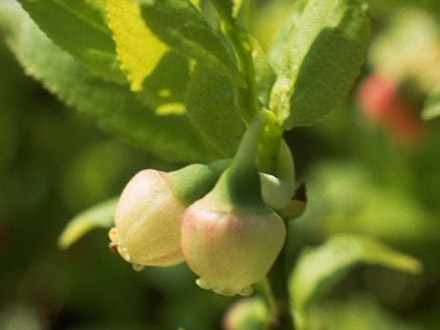Botanical name
Vaccinium myrtillus L.
Family
Ericaceae
Common name
European blueberry, Whortleberry, Blaeberry, Wimberry
Information about the plant
Bilberry grows as an undergrowth in light pine and spruce forests, and on the moors in central and northern Europe, Asia, and North America, extending to alpine levels in the south. It plays an important role among the native wild berries, but today it is hardly collected from the wild for the commercial food industry, except possibly in Austria and the Balkans. However, bilberries for pharmaceutical purposes are almost exclusively sourced from the wild. The ripe berries are separated by a special combing of the plant, then either dried or immediately frozen and preserved.
The genus name Vaccinium is derived from the Latin 'bacca' (= berry) and 'baccinium' (= berry bush). It is also used for the lingonberry (V. vitis-idea), the bog bilberry (V. uliginosum), and the small cranberry (V. oxycoccos). The species epithet myrtillus also has Latin roots and is derived from 'myrtus' (= myrtle) and refers to the resemblance of the bilberry leaves to the myrtle leaves. In fact, they are as leathery as those of myrtle, but smaller, which is why the diminutive form myrtillus was created. In the German name “Heidelbeere”, the 'l' in “Heidel” is a suffix expressing affiliation: just as the “Eichel” belongs to the oak, the “Heidel” belongs to the heather (also arm and sleeve).
The bilberry is a deciduous dwarf shrub, 20 to 50cm high, with sharp-edged branches which bear ovate, very short petiolate leaves with finely serrated edges. The pale red to green, bell-like flowers are borne in the leaf axils. The fruits are spherical, blue-black, frosted white, very juicy, and sweet.
Medicinally used parts of plants (herbal drug)
The ripened fruits are used both in dried form (dried bilberry fruits - Myrtilli fructus siccus) and as fresh berries (fresh bilberry - Myrtilli fructus recens). The dried leaves (bilberry leaves - Myrtilli folium) are also used.
The commercially available drug comes mainly from south-eastern Europe, but also from Italy and the USA.
Constituents of the herbal drug
Bilberry fruits contain anthocyanins, while dried fruits also contain catechin tannins and inverted sugar.
Bilberry leaves contain catechin tannins, flavonoids, phenolcarboxylic acids, and iridoids.
Quality of the drug
The quality of the following drugs or drug preparations is specified in the European Pharmacopoeia (Ph. Eur.):
- Dried bilberry (Myrtilli fructus siccus)
- Fresh bilberry (Myrtilli fructus recens)
- Adjusted (standardized), purified dry extract of fresh bilberries (Myrtilli fructus recentis extractum siccum raffinatum et normatum)
Medical applications
Recognised medical use
Dried bilberries
The HMPC has classified dried bilberries as a traditional herbal medicinal product (see “Traditional use”).
ESCOP: for non-specific, acute diarrheal diseases; externally for local therapy of mild inflammation of the oral and pharyngeal mucosa and superficial wounds. These areas of application are based on long-standing use in humans.
Fresh bilberries
The HMPC has classified fresh bilberries as a traditional herbal medicinal product (see “Traditional use”).
Fresh bilberries are used exclusively to produce anthocyanin-rich extracts that are processed into finished medicinal products.
ESCOP has formulated the following indication: supportive for complaints associated with varicose veins such as aching and heavy legs; for microcirculatory disorders of the eye and peripheral vascular insufficiency (see also “Traditional use”).
Bilberry leaves
The HMPC has closed the evaluation of bilberry leaves due to insufficient data.
Due to their astringent effect (tannins), bilberry leaves can only be used internally as a tea infusion for mild diarrhea for short periods and externally for rinsing and washing (popular use). However, caution is advised with claims such as “sugar tea” or “anti-diabetic tea” and “to lower blood pressure”, with which bilberry leaves are sometimes advertised and offered in alternative markets.
Traditional use
Dried bilberries have been classified by the HMPC as a traditional herbal medicinal product (Article 16a of Directive 2001/83/EC). Based upon long-standing use, dried bilberries can be used internally for mild diarrhea and externally for mild inflammation of the oral mucosa.
Fresh bilberries have been classified by the HMPC as a traditional herbal medicinal product (Article 16a of Directive 2001/83/EC). Based upon long-standing use, dry extracts of fresh bilberries (DER 153-76:1; extraction solvent methanol 70%; anthocyanosides content 25%) can be used internally for discomfort and heaviness in the legs associated with mild venous insufficiency and to relieve the symptoms of skin capillary fragility (spider veins).
Anthocyanins from fresh bilberry fruits are traditionally used to prevent night blindness (registration as a traditional medicinal product).
Herbal drug preparations in finished dosage forms
- Dried bilberries for decoctions
- Anthocyanins from fresh bilberry fruits in coated tablets
- Chopped bilberry leaves for tea preparation
Dosage
Finished medicinal product: see patient information leaflet.
Tea: Dried bilberries: drink 1 cup of freshly prepared bilberry fruit tea several times a day. Daily dose 20 to 60 g drug. Children can also eat 10 g of dried bilberries several times a day or eat the berries previously pre-soaked in water as porridge.
To improve night vision, only the intake of ready-to-use medicines with standardized extracts is recommended (single doses of 100 mg anthocyanins).
Bilberry leaves: for diarrhea, drink 1 cup of bilberry leaf tea 3 to 4 times a day.
Preparation of a tea
Dried bilberry fruit: Add 150 mL of cold water to 5 to 10 g of crushed bilberry fruit, heat the mixture to boiling point, remove from the heat after 10 minutes, and strain while still hot.
Bilberry leaves: 1 to 2.5 g of finely chopped bilberry leaves are mixed with 150 mL of boiling water and strained after 5 to 10 minutes.
Notes
Bilberry fruit: If diarrhea persists for more than 3 to 4 days, consult a doctor.
Use in children under 4 years of age is not recommended due to a lack of evidence.
Caution: Fresh bilberries have a slightly laxative effect!
Bilberry leaves: Prolonged use of bilberry leaves in high doses can lead to poisoning symptoms, which is why it is not recommended.
Side effects
None known.
Interactions
None known.
References
Herbal drug monographs
HMPC (2015, 2023), ESCOP (2014), WHO Vol. 4
Further literature
Commentary on the European Pharmacopoeia (Dried bilberries, No. 1588; Fresh bilberries, No. 1602; Standardized, purified dry extract of fresh bilberries, No. 2394)


